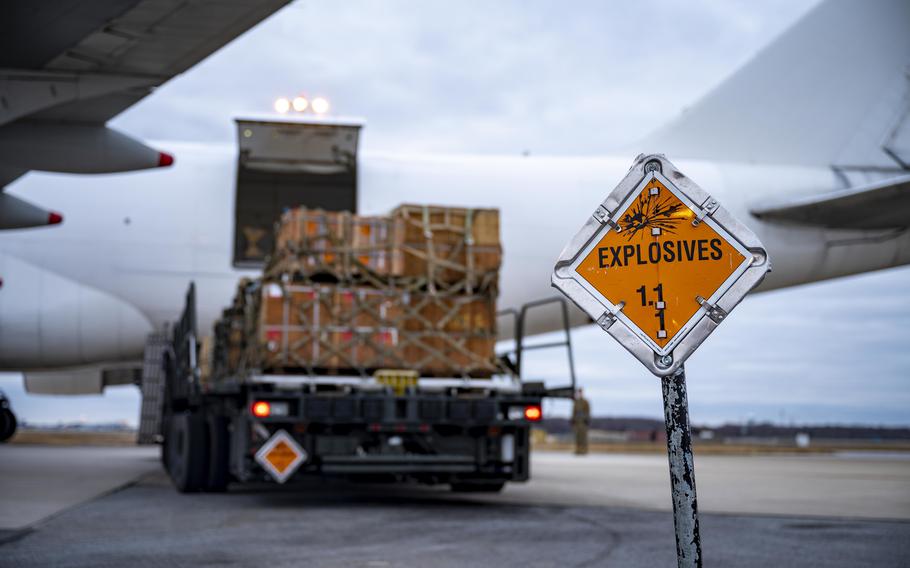
An explosives sign marks the cordon around a commercial aircraft during a security assistance mission at Dover Air Force Base, Del., on Jan. 13, 2023. Since the Russian invasion in February 2022, Ukraine has been given roughly $45 billion in U.S. military aid that has included a wide range of weapons such as air-defense systems, anti-drone systems, various missiles and rockets and small-arms ammunition. (Amanda Jett/U.S. Air Force)
WASHINGTON — More than $1 billion in military weapons and equipment that the United States has provided Ukraine to fight invading Russian forces cannot be accounted for and is not being fully tracked, according to a Pentagon audit released Thursday.
Since the Russian invasion in February 2022, Ukraine has been given roughly $45 billion in U.S. military aid that has included a wide range of weapons such as air-defense systems, anti-drone systems, various missiles and rockets and small-arms ammunition. The Defense Department inspector general concluded in the report that about $1 billion in weapons that are required to be tracked have not been.
“High rates of delinquency may correlate with an inability to maintain complete accountability of the … defense articles, which, in turn, may increase the risk of theft or diversion,” the 92-page report states. “Achieving a complete picture of [the] defense articles in Ukraine will be difficult as the inventory continues to change, and accuracy and completeness will likely only become more difficult over time as the total number of … defense articles in Ukraine continues to change.”
The weapons audit comes at a time when Congress is debating whether to send more military aid to Ukraine. Almost all previously authorized money for providing weapons and equipment to Ukraine has been spent, and President Joe Biden is asking Congress for tens of billions more for 2024 as part of a supplemental funding request. But no new aid money has been approved.
The report, which is partly redacted, does not say exactly how many weapons have not been tracked. However, The New York Times — citing the unredacted report — wrote the total is about 40,000. The audit said there’s no indication yet that any of the weapons have been stolen or intercepted.
“It was beyond the scope of our evaluation to determine whether there has been diversion of such assistance,” according to the report.
The untracked weapons are subject to what the Pentagon calls enhanced end-use monitoring, or EEUM, requirements. Equipment that falls under the EEUM category requires heightened accountability and security due to its sensitive technology and smaller size, which makes it more appealing to arms traffickers.
The report issued Thursday said the United States had given Ukraine about $1.7 billion in EEUM-designated weapons by mid-2023.
“While the DOD has improved execution of EEUM since the full scale [Russian] invasion began in February 2022, the DOD did not fully comply with the EEUM program requirements for defense article accountability in a hostile environment,” according to the audit. “Although [U.S. and Ukrainian] personnel conducted some required inventories, as of June 2, 2023, serial number inventories for [almost 60%] of EEUM designated defense articles remained delinquent.”
“This occurred for multiple reasons, including the limited number of [U.S.] personnel at logistics hubs in a partner nation and in Ukraine, the absence of procedures for conducting EEUM in a hostile environment until December 2022, the movement restrictions for EEUM personnel within Ukraine and a lack of internal controls,” the report reads.
The inspector general’s report makes several recommendations to improve accountability for EEUM weapons sent to Ukraine. They include improving inventory processes to keep track of the hardware, improving “timely and accurate reporting” for the weapons, better documentation of third- party transfers, putting serial numbers of all EEUM weapons in a central database and adding internal controls to verify that the database is updated within a required time.
In response, the Pentagon concurred with some of the recommendations but emphasized that keeping track of tens of thousands of weapons can be difficult because of the dangerous conditions in Ukraine and there’s limited personnel available to make the weapon checks.
“While battlefield losses of EEUM articles can and do occur during an active conflict, to date there is no evidence of unauthorized or illicit transfer of U.S.-origin articles outside of Ukraine,” Alexandra Baker, acting undersecretary of defense for policy, wrote in a response letter to the audit. “Given the closure of the U.S. Embassy in Kyiv from February to June 2022 and hostile conditions likely to persist in Ukraine for the long term, ‘full accounting’ of EEUM articles in the manner described is an unrealistic and unobtainable expectation.”